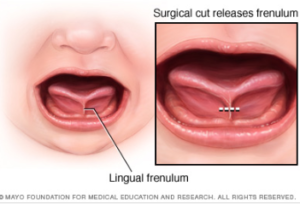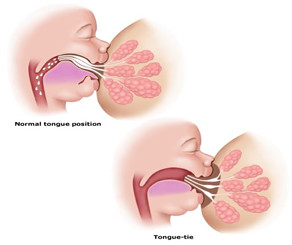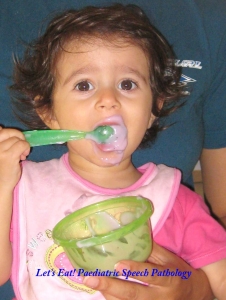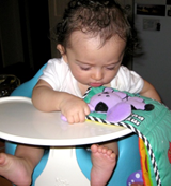
Babies with tongue ties (medically termed as “Ankyloglossia”) are one of the common referrals Paediatric Feeding Speech Pathologists get. They are usually diagnosed at birth and regardless of feeding method, most mothers worry about the impact of their baby’s tongue tie on feeding and speech development.
Source of picture: http://www.mayoclinic.com/health/medical/IM04660
Is it common?
The incidence of tongue tie varies with more recent studies (Messner et al 2000 & Ricke et al 2005) noting it to be between 4-5%. It is more common in males than females but the incidence is difficult to accurately rate due to lack of agreed definitions on tongue ties. Something to know as a parent is that tongue ties will stretch as your baby grows. This is because your baby’s oral cavity is still developing in shape and size. So too is their tongue, it will grow and narrow at the tip (Kummer 2005).
Will Tongue Ties impact on Feeding?
To answer this, you need to think about how the tongue is working when your baby is feeding. When I assess a patient, I am more concerned about “function” rather than “structure” of tongue ties. To breastfeed well, your baby needs to keep their tongue tip over their lower gum and therefore bottle feeding is quite often seen as easier (Wolf & Glass 1992). Please remember that breast feeding in newborns can take a few days or sometimes even weeks to establish so don’t be quick to blame their tongue tie, most babies (and parents) are learning about good attachment on the breast and most mother’s breastfeeding milk can take a few days to “come in”.
Source of picture: http://www.knowabouthealth.com/snip-tongue-tie-to-aid-breastfeeding-in-infants/3867/
The symptoms of a tongue tie impacting on breastfeeding might be:
- Difficulty latching or maintaining attachment on a breast
- Continuous “snacking”/feeding on the breast
- Babies’ frustration at the breast when trying to feed or after breast feeds
- “Gumming” or chewing on the breast rather than sucking
- Risk of nipple pain, poor let down and mastitis for mums
- Risk of poor weight gain for baby
If you are seeing these symptoms when breastfeeding or bottle feeding your baby with a tongue tie (or even undiagnosed tongue tie). Talk to your doctor and Paediatric Feeding Speech Pathologist (like us!), we can recommend some strategies to help you breastfeed successfully (however some severe tongue ties may need to be surgically clipped).
What about transition to solids?
It depends on the severity, keep in mind that your baby’s mouth is growing and developing as they grow too. Some babies with tongue ties may have:
- Difficulty chewing lumpy foods because their tongues may not move foods to the sides of their mouth efficiently enough.
- May have difficulty clearing their top lip or side teeth after eating (i.e. tongue sweeping)
- They may be more likely to be messy with eating and take longer
- May dribble a bit more as toddlers.
There is very little published research on the impact of tongue ties on eating skills. Like with any child, keep on top of regular teeth brushing/oral hygiene and talk to your Paediatric Feeding Speech Pathologist if your child is having difficulties transitioning to solids.
Will Tongue Ties impact on speech?
This remains controversial. The universal agreement is that tongue ties do not prevent or delay the onset of speech (Kummer 2005). Think about the sounds that need the tongue tip movement –
- ‘t, d, n’ sounds need the tongue tip to touch the roof of the mouth however can be done using the main part of the tongue.
- ‘l,s,z’ sounds although commonly use the tongue tip can also be produced with the tongue pointing down
- ‘ r’ sounds are similarly produced as long as the back of the tongue stays up
- ‘th’ sounds is the most that the tongue has to move forward and so along with ‘l’ sounds, this will depend on the severity of your child’s tongue tie. Most children with tongue ties are able to adapt their oral movements to produce all of the above sounds quite successfully.
If you are concerned about the clarity of your child’s speech, talk to your local Speech Pathologist who can assess their oral movements (including the structure and function of tongue tie) and assess whether there are other confounding factors that might be affecting their speech and language development.
What about upper Lip ties?
This is where a piece of skin under your baby’s upper lip is very short or thick or attached very tightly to their upper gum. They are commonly associated with tongue ties and can restrict your baby’s ability to “flange” (attach) onto the breast or bottle. As your baby gets older and their teeth come through, you may notice a gap developing between their front teeth. If you are concerned about this, it’s best to talk to your Paediatric Feeding Speech Pathologist and Paediatric Dentist.
What about surgery?
There continues to be controversy about the significance of tongue ties and whether to clip or not to (early release or late release?). There are 2 ways to release a tongue tie; a Frenotomy is commonly done in Paediatric Surgeons, Ear Nose and Throat Doctors, Dentists and some GP’s offices here in Australia. There is also another procedure called a Frenuloplasty which is a surgical release of a tongue tie requiring anaesthetic. It allows complete release of the tongue tie and is the preferred procedure for babies over 12 months of age.
Ultimately it is your decision as a parent whether to clip or wait. Unfortunately there is no “one answer fits all”. If you are having feeding difficulties, consider seeing your Lactation Consultant and/or Paediatric Feeding Speech Pathologist (ideally we work together really well!). If you are concerned about solids or speech development, seek an assessment by a Speech Pathologist. And finally, if you want to discuss surgical options, talk about the pros and cons with your GP and Paediatrician.
References
Kummer, A. (2005). Ankyloglossia: To clip or not to clip? That’s the question. The ASHA Leader, 10 (17), 6-7,30.
Ricke, L.A., Baker, N.J, Madlon-Kay, D.J, DeFor, T.A (2005). Newborn tongue tie: Prevalence and effect on breastfeeding. Journal of the American Board of Family Practice, 18(1), 1-7
Messner AH, Lalakea ML. Ankyloglossia: controversies in management. International Journal of Pediatric Otorhinolaryngol 2000; 54: 123-31.
This website and information on this blog post is provided for educational purposes. It is not meant or intended to replace Speech Pathology assessment and management nor medical or nutritional care for a child. It is recommended that you discuss any concerns or questions you might have with your Speech Pathologist and managing Doctor and develop an individualised team plan specifically for your child.
About the author of this blog post
Valerie is an Australian based Speech Pathologist with 10 years experience in Paediatric Feeding. She has recently opened a private practice called ‘Let’s Eat! Paediatric Speech Pathology’ that caters for Newcastle based babies and children with feeding difficulties and early intervention language delays. Valerie is passionate about working in the area of paediatric feeding and special needs and has been involved in the teaching and training of Australian Speech Pathology University students and allied health professionals. You can find out more about Valerie Gent and ‘Let’s Eat! Paediatric Speech Pathology’ via her website www.letseatspeech.com.au and Facebook page www.facebook.com/LetsEatPaediatric SpeechPathology or email her on valerie.gent@letseatspeech.com.au






One thought on “Tongue Ties – will it affect your child’s feeding skills and speech skills?”
Comments are closed.